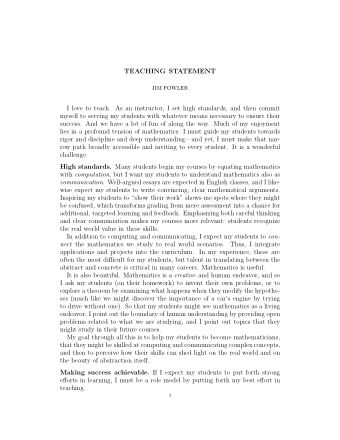Teaching Statement
I love to teach. As an instructor, I set high standards, and then commit myself to serving my students with whatever means necessary to ensure their success. And we have a lot of fun of along the way. Much of my enjoyment lies in a profound tension of mathematics: I must guide my students towards rigor and discipline and deep understanding—and yet, I must make that narrow path broadly accessible and inviting to every student. It is a wonderful challenge.
High standards
Many students begin my courses by equating mathematics with computation, but I want my students to understand mathematics also as communication. Well-argued essays are expected in English classes, and I likewise expect my students to write convincing, clear mathematical arguments. Inspiring my students to “show their work” shows me spots where they might be confused, which transforms grading from mere assessment into a chance for additional, targeted learning and feedback. Emphasizing both careful thinking and clear communiation makes my courses more relevant: students recognize the real world value in these skills.
In addition to computing and communicating, I expect my students to connect the mathematics we study to real world scenarios. Thus, I integrate applications and projects into the curriculum. In my experience, these are often the most difficult for my students, but talent in translating between the abstract and concrete is critical in many careers. Mathematics is useful.
It is also beautiful. Mathematics is a creative and human endeavor, and so I ask my students (on their homework) to invent their own problems, or to explore a theorem by examining what happens when they modify the hypotheses (much like we might discover the importance of a car's engine by trying to drive without one). So that my students might see mathematics as a living endeavor, I point out the boundary of human understanding by providing open problems related to what we are studying, and I point out topics that they might study in their future courses.
My goal through all this is to help my students to become mathematicians, that they might be skilled at computing and communicating complex concepts, and then to perceive how their skills can shed light on the real world and on the beauty of abstraction itself.
Making success achievable
If I expect my students to put forth strong efforts in learning, I must be a role model by putting forth my best effort in teaching.
Each student is helped best in a different way, so my first step is information gathering; homework and tests are an obvious assessment tools, but lecture can be, too. I use lecture time to take instant surveys of the class (i.e., “close your eyes, raise your hand if you have been following”), or to give instant quizzes (i.e., “work on the following and signal when you think you have it figured out; discuss with your neighbor”). Instead of watching mathematics, this gets everyone doing mathematics and talking about mathematics; as a side benefit, it gives me an idea of how the class is handling the material, so I can adjust immediately.
I have been experimenting like this to make my lectures as engaging as possible: I have made paper slide rules to let my students feel logarithms, used actual soap bubbles after solving the related minimization problem, distributed paper models, played sounds corresponding to functions and their derivatives, stacked a stable tower of wooden blocks in the harmonic series, etc. “Lecture” means much more than me, talking. I want to do everything I can so that my students respond enthusiastically with hard work on the problem sets.
I do my best to create interesting problem sets. By combining the textbook's problems with mini-projects, multi-part problems, applications, proofs, conceptual questions, I hope to provide questions to entice every student, to reward struggling students with success and challenge successful students to work even harder. Weekly problem sessions and exam review sessions provide organized time to discuss these problems and share ideas; my office hours provide one-on-one time for instant feedback.
My goal is to provide a variety of resources with which to help my students achieve high standards. Every topic I teach has something simply awesome about it, and I want to make sure every student has the chance to experience it, whether in lecture, in office hours, or in working through problems.
Conclusion
Teaching is a blessing, and I am excited to continue to improve my talents that I might serve my students better.
